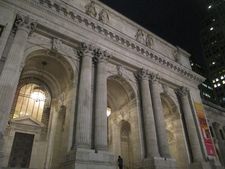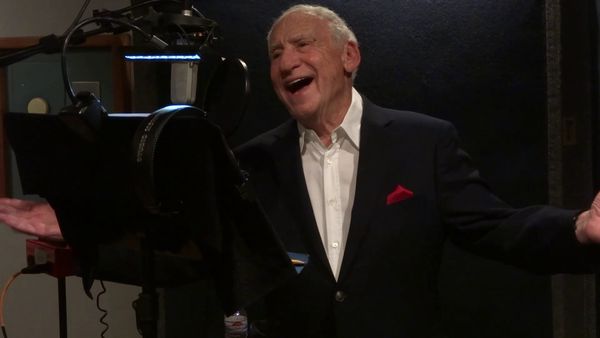 |
| Mel Brooks performing the wonderful song (There Was Nothing Like The Coffee) At the Automat, he wrote for the score of The Automat, directed by Lisa Hurwitz |
The Automat (a highlight of the 12th edition of DOC NYC as a Special Event screening and a must-see at the upcoming 14th Hamptons Doc Fest) features many memorable on-camera interviews, including Ruth Bader Ginsburg, Carl Reiner, Elliott Gould, Colin Powell and the irrepressible Mel Brooks.
Once upon a time, in the not so distant past, there existed a chain of very special restaurants that appealed to children and adults, rich and poor, people from all kinds of background. It married playfulness and efficiency. The food was good, fresh, local, inexpensive and came displayed in little windows, you could open yourself after putting some nickels in the slot. Small dolphin spouts, inspired by Roman fountains, dispensed the coffee, which you could sip at marble tables for as long as you wanted.
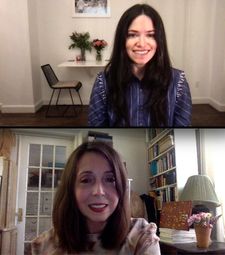 |
| Lisa Hurwitz with Anne-Katrin Titze answering Mel Brooks question: “I started researching cafeteria history in my school library and I came across the Automat.” |
Lisa Hurwitz’s entertaining and informative The Automat chronicles the iconic institution of American hospitality from its beginning in June 1902, when Joesph Horn and Frank Hardart opened their first incarnation of the Automat in Philadelphia. Black and white stills of Audrey Hepburn, James Dean or Burt Lancaster and the fabulous score by Mel Brooks’s longtime composer Hummie Mann lure us into time-travel mode. The people interviewed become children again before our eyes as they recount their memories, be they a Supreme Court judge, a Secretary of State, the mayor of Philadelphia, or the Executive Chairman of Starbucks.
There is plenty to learn about this most American of places, which was, incidentally, inspired by European automatic restaurants Hardart researched during his trips to Germany. The Automat provided food for the troops leaving New York during World War II, fed women who entered the workforce in the Twenties and Thirties, helped many through the Great Depression, and gave immigrants with rudimentary knowledge of English a chance to eat out without feeling intimidated.
Only when during the Fifties Americans were enticed to move to the suburbs and women were coaxed back into the home after the war, began the Automat’s slow decline. Advertising pushed America to a “modern” way to eat. Processed, frozen, pre-packaged, brightly coloured, and fast food took hold and rang in the end of the elegant democratic lunch palaces of yesteryear.
From Los Angeles, Lisa Hurwitz joined me on Zoom for an in-depth conversation on The Automat.
Anne-Katrin Titze:: Hi! How are you?
Lisa Hurwitz: I’m good. Wow, I love your setup, it’s so nice.
 |
| Lisa Hurwitz on contacting Ruth Bader Ginsburg: “I first actually reached out to her by sending a letter in the mail to the United States Supreme Court.” |
AKT: Thank you. Yours too! You are somewhere warm?
LH: This week is Thanksgiving and I’m in Los Angeles visiting my mom. Right now I’m in her Los Angeles backyard. It’s not a bad place to be working from.
AKT: I see you throwing a ball to an animal! Perhaps a dog?
LH: Yes, my mom’s dog needs a lot of stimulation. Do you have any pets?
AKT: Not at the moment, but I love animals. I’m a wildlife rehabilitator.
LH: Oh wow, that’s fabulous. I volunteer at an animal shelter.
AKT: I saw in the end credits - in memory of Charlie. Was that your dog?
LH: Yes, he passed away right before the pandemic.
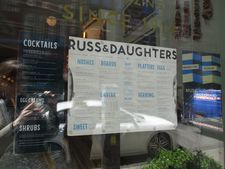 |
| Lisa Hurwitz on seeing Ruth Bader Ginsburg in Julie Cohen’s The Sturgeon Queens: “I made a guess that if she ate at Russ & Daughters, she also ate at the Automat.” Photo: Anne-Katrin Titze |
AKT: I understand how they are like family. About your film, I want to pick up where Mel Brooks left off. One of the questions he asked, you didn’t answer: “So what possessed you?” What was your personal attraction to the Automat? How did it come about?
LH: It came about because I loved, even adored my school cafeteria when I was a student in university and that was when this all began. I started researching cafeteria history in my school library and I came across the Automat. The research expanded, I went to New York to visit the New York Public Library during my holiday vacation. It kind of clicked when I saw how much material there was and nobody had made a full-length documentary yet.
I was a 35mm projectionist at that time. I was working at a movie palace from the 1920s. It started as a little two-minute short film just for fun and then it started getting bigger. What possessed me was that it seemed like a really good idea. I had gotten this understanding that this was much more than a restaurant. It was a place where people spent a good chunk of their lives and cared deeply for. I’m a sentimental person and it seemed like a nice thing to do. If I had known in the beginning how much work and how long it was going to take, how expensive it was going to be, I can’t say I would have necessarily said yes.
 |
| Audrey Hepburn at the Automat in New York, 1951 Photo: Lawrence Fried |
AKT: But think of all the people you encountered just in time! You made it at the cusp. Now you would not be able to make the same film, because some of your subjects died. It’s such a unique place and even if you never had a chance to be there, you feel it. I obviously have never been to one, but I remember watching [Delbert Mann’s] That Touch of Mink with Cary Grant and Doris Day, and it in a way epitomized New York, epitomised America. This is how people eat there, this is how people interact there; this magical ordinary place!
LH: I think you’re completely right! By the way, you look great. You’re right, it epitomized New York, it captured its moment. On a larger level, it’s more than just a restaurant, it’s about New York at that particular moment and it’s about the world changing over the course of a hundred years. The Automat is actually a perfect window onto the world around it. Along the way I began to realize that there was something more important and meaningful here than I had originally seen.
AKT: The fun is there but there is depth to it. When we e-mailed, I asked you if the thanks in the credits is for the Julie Cohen I just spoke to about her film Julia and you said yes. Did she connect you to Ruth Bader Ginsburg? Also there is the issue of how America’s eating habits changed. For the Automat you have people talking about how everything was fresh and seasonal. In the Fifties the change began to fast food, frozen food, something the nation is still suffering from.
LH: Before I ever even contacted Julie, I had seen her film The Sturgeon Queens (2014) about Russ & Daughters fish shop in New York. That’s when I got the idea to contact Ruth Bader Ginsburg, because she did such a nice job talking about growing up in New York and the food that she ate. I made a guess that if she ate at Russ & Daughters, she also ate at the Automat. And that was correct. I first actually reached out to her by sending a letter in the mail to the United States Supreme Court.
AKT: Great!
LH: And she responded to the letter. She sent me back a letter. I was in touch with Julie about it, I introduced myself and told her what I was doing. With me she was very happy to answer my questions, share information, give me advice, look at an early cut of the film. I admire Julie for that. But keep in mind, this was before RBG. Julie’s career kind of blew up more recently. I connected with Julie before the Oscars.
AKT: Let’s stay in touch!
LH: Let’s stay in touch, absolutely! Thank you very much.
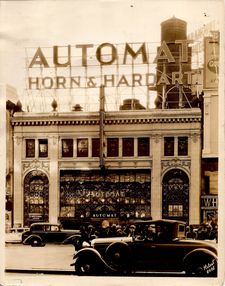 |
| The Automat at 1557 Broadway in New York City Photo: John W Romas, collection of Horn & Hardart |
Coming up on the week of the theatrical release in 2022 - Lisa Hurwitz on Colin Powell, editor/writer Michael Levine, Mel Brooks, composer Hummie Mann, the Edward Hopper painting, a Jack Benny event held at the Automat, movie clips filmed there and the beloved baked beans.
The Automat screens on Saturday, December 4 at 12:00pm with an in-cinema Q&A by Lisa Hurwitz at the Sag Harbor Cinema.
Hamptons Doc Fest in cinemas (Sag Harbor Cinema, Bay Street Theater) runs from Friday, December 3 through Friday December 10. Select films are screening online in the US from December 11 through December 18.
DOC NYC in-cinema Special Event screening of The Automat took place on Monday, November 15.
DOC NYC 2021 in cinemas (IFC Center - SVA Theatre - Cinépolis Chelsea) ran from November 10 through November 18. Select films are screening online in the US from November 19 through November 28.
The Automat opens on February 18, 2022 at Film Forum in New York.








